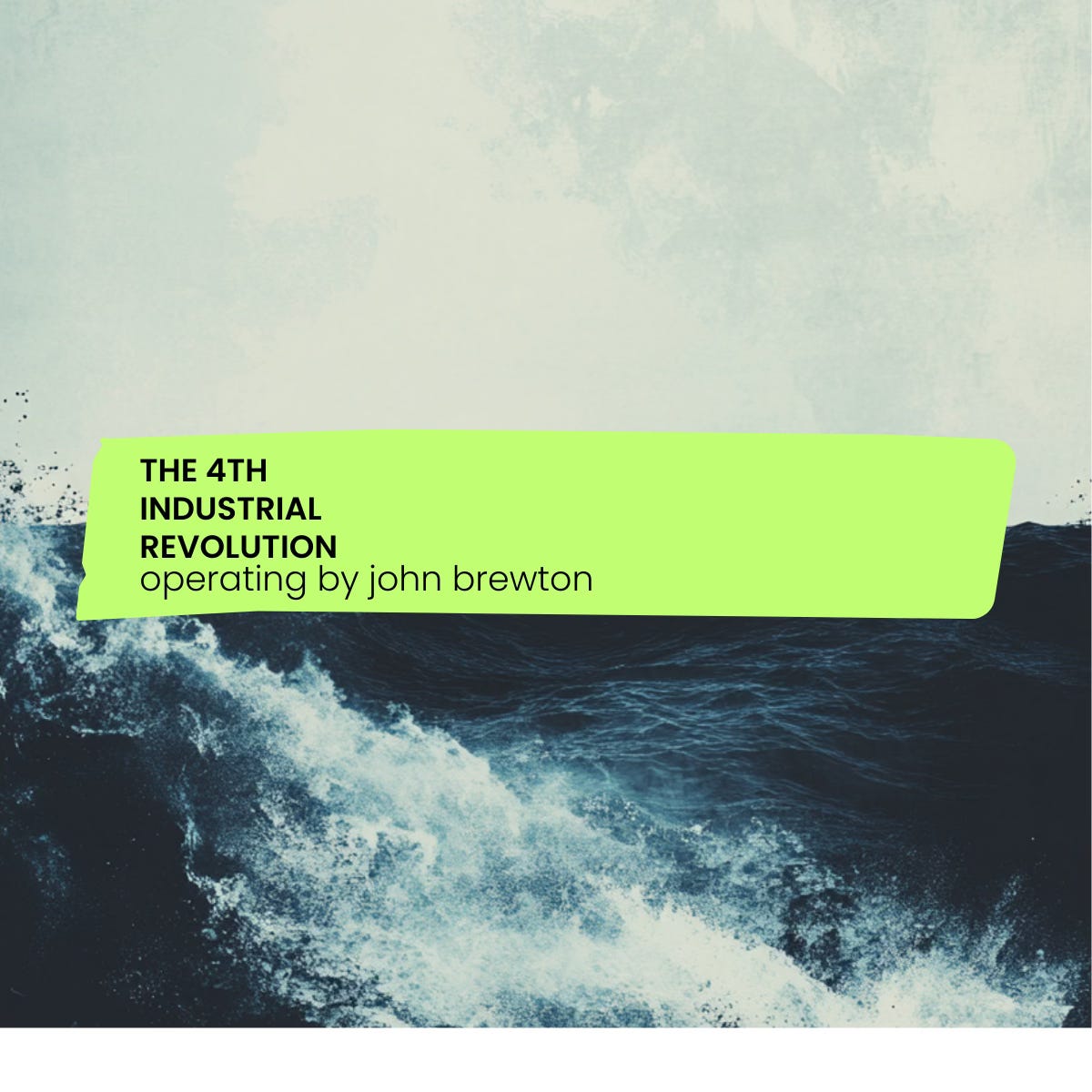The 4th Industrial Revolution
Artificial intelligence is the visible frontier, but it is not the whole story.
In 2012, Tesla was a niche electric car manufacturer burning through cash with fewer than 3,000 employees. Today, it's simultaneously an automotive company, energy storage provider, solar panel manufacturer, autonomous driving software developer, and charging network operator, worth more than most traditional automakers combined. Tesla demonstrated how the convergence of technology, economics, and strategy can create entirely new competitive landscapes, where traditional market and competitive boundaries dissolve.
We are living through a convergence of three powerful forces: technological acceleration driven by the Fourth Industrial Revolution, economic restructuring that is reshaping value creation, and an operating strategic transformation that renders traditional frameworks increasingly obsolete.
Value creation, capture and distribution are being restructured.
The companies that navigate this moment successfully will define the next business epoch. Those that don’t will find themselves increasingly irrelevant, regardless of current market position or historical success.
1. Technological Acceleration: Beyond Linear Progress
The Fourth Industrial Revolution is exponential, as it should be. It is exponential in its influential breadth, aggregating across AI, robotics, biotechnology, energy systems, and networks. These technologies won’t continue their development in isolation, they are converging. Machine learning designed for internet search now powers medical diagnostics.
Blockchain underpins supply chains. Gaming engines train autonomous vehicles. Renewable energy, once niche, now integrates with smart grids and battery storage.
Artificial intelligence is the visible frontier, but it is not the whole story. The falling cost of genome sequencing, the rapid improvement in solar panel efficiency, and the ubiquity of mobile computing all illustrate market shifting change has been unfolding for decades. We are all familiar. AI has simply crystallized this reality, bringing the broader revolution into sharp relief.
Linear corporate planning fails in the new environment. A technology that looks irrelevant today can dominate in five years. Amazon’s Alexa went from concept to ubiquity in less time than most automakers develop a new model. As I previously asserted, Schumpeter’s “creative destruction” is happening in fast-forward; Christensen’s innovators are disrupting incumbents more quickly; and Thiel’s “zero-to-one” leaps are no longer rare, they are multiplying.
Platform economics amplifies this effect. Apple, Google, and Amazon are not only consumer technology companies, they create digital infrastructure for retail, healthcare, and finance. Their platforms are increasingly the foundations upon which entire economic ecosystems operate.
2. Economic Disruption and Restructuring
Traditional linear value chains are dissolving. In their place are networked ecosystems where value is created through data flows, connections, and collaborative innovation. Facebook adds users at near-zero cost while its network value compounds. Data, not physical assets, are the new strategic capital. Unlike infrastructure, data increases in value the more it is used and shared.
This is not sudden. The dot-com bust normalized mass internet adoption and early platform models. The global financial crisis shattered trust in institutions and accelerated fintech. COVID-19 forced entire industries into remote, digital-first operations. The AI boom is simply the most visible acceleration of a 20-year restructuring already underway.
The pace of creative destruction has accelerated dramatically. Kodak invented the digital camera yet was destroyed by it. Blockbuster laughed at Netflix. BlackBerry created the smartphone, but Apple built the ecosystem. In We Are All Becoming Operators, I offered that the fundamental unit of value is shifting from firms and hierarchies to distributed operators connected through digital infrastructure.
Traditional economic metrics struggle to keep up. GDP captures rebuilding after hurricanes as growth but misses the value of free services like Wikipedia. The measures of economic vitality have not kept pace with digital realities.
3. Strategic Paradigm Shifts
Michael Porter’s famous framework, cost leadership, differentiation, focus, was built for stable industry boundaries. But those boundaries have collapsed. In Scaling Down the Big Ideas, we discussed why Porter’s Five Forces no longer map to the networked and platform-driven dynamics that dominate digital competition.
Agility now matters more than position. The ability to sense, experiment, and adapt beats optimization of the status quo. Amazon’s “Day 1” philosophy embodies this. Ecosystem thinking replaces zero-sum rivalry: Apple’s App Store enriches millions of developers while strengthening Apple itself. Even Tesla open-sourced its patents, recognizing the market grows stronger with more participants.
Speed now beats scale. In digital markets, first-mover advantages lock in network effects. Google’s early dominance in search reinforced itself through data. Facebook scaled fast enough to acquire competitors before they grew dangerous. Velocity is often the most advantageous variable.
Manifestations
Industry Transformation
Convergence reshapes industries across boundaries. Fintech companies like Stripe and Square are not just digitizing payments, they combine commerce, analytics, and finance into bundled platforms. Healthcare offers another example: telemedicine went from marginal to essential almost overnight during COVID-19. AI-enabled diagnostics and remote devices are transforming medicine from reactive treatment to predictive care.
Amazon’s logistics revolution exemplifies convergence. By combining e-commerce, robotics, data analytics, and cloud infrastructure, it built an ecosystem competitors cannot replicate. Likewise, Tesla’s integration of cars, solar, and batteries makes it as much an energy company as an automaker.
Geographic Divergence
Different geographies illustrate different models of convergence. China’s super-apps integrate messaging, payments, commerce, and government services into a single layer of infrastructure. The state directs convergence toward national goals. Silicon Valley pursues it through venture capital, talent, and platform scaling. Europe responds with regulation, prioritizing sovereignty, privacy, and fairness.
These competing approaches suggest a fragmented digital economy, where interoperability itself becomes a strategic challenge.
The Leadership Challenge
Strategic Imperatives
Digital transformation is no longer about tools—it’s about culture and operating philosophy. As I showed in Andy Grove’s Playbook for Operators, Grove’s concept of “strategic inflection points” offers one of the most relevant guides here. Leaders must recognize when industry dynamics shift by an order of magnitude and adjust before their position collapses.
Leaders must integrate technology with culture. Netflix evolved from DVDs to streaming to producing content not by technology alone, but by creating a culture willing to cannibalize old business models. Amazon’s $700 million reskilling commitment underscores how talent strategy is as critical as infrastructure. And companies like Microsoft under Nadella show that openness to partnerships can revitalize even the most entrenched firms.
Organizational Capabilities
Adaptive governance replaces bureaucracy. Experimentation and learning replace rigid processes. As was previously noted, AI-native firms like Cluely illustrate how lean teams with no middle managers can outpace institutions with thousands of employees.
Data literacy and ethical frameworks are no longer optional. Decision-makers across functions must be able to interpret data, question algorithms, and weigh ethical tradeoffs. The convergence of economic and technological power demands responsibility.
Risks and Consequences
Convergence creates systemic risks. Platform concentration centralizes too much power in a handful of companies. Cyber vulnerabilities cascade across sectors. Skills displacement threatens not only manufacturing workers but lawyers, accountants, and analysts. Privacy erosion and information warfare undermine democratic discourse.
Environmental impacts of digital infrastructure also loom large. Data centers already consume nearly 1% of global electricity. Cryptocurrency mining adds further strain.
All of this deserves exponentially more consideration in future articles.
Opportunities
Convergence creates extraordinary new markets. Sustainable technologies, the space economy, biotechnology, and immersive virtual environments are all products of technological and economic collaboration across firms, governments, universities and people. The opportunity lies in building ecosystems that balance economic advantage with societal benefit.
Democratizing education through AI tutors, expanding healthcare access via telemedicine, and accelerating science through machine learning portend profound societal upsides.
Framework for Leaders
Leaders need practical frameworks to navigate convergence:
Audit readiness: Assess technology infrastructure, talent velocity, cultural adaptability.
Scenario stress tests: Optimize for resilience under multiple possible futures.
Stakeholder mapping: Understand all actors influenced by ecosystem decisions.
Continuous horizon scanning: Monitor weak signals before they become disruptive waves.
Transformation unfolds in three phases: build foundations (infrastructure, culture), develop capabilities (partnerships, innovation systems), and then position strategically (market creation, ecosystem leadership, platform development).
Traditional KPIs like revenue and profit must be supplemented with new measures: network strength, data asset value, ecosystem health, and innovation velocity.
How to Thrive
The convergence of technology, economics, and strategy creates both opportunities and existential risks. Leaders who understand and act will define the systems that emerge from this period of change. As I’ve argued before, the real strategic asset now is not efficiency but adaptability, not hierarchy but ecosystems, not jobs but operators.
The Fourth Industrial Revolution is about convergence, the layering of decades of technological progress, global economic shifts, and strategic transformation into a single moment of upheaval. AI makes this visible, but it is only one thread in a much larger tapestry. AI is an accelerant, not the revolution itself.
The organizations that thrive will not treat convergence as a threat to endure but as an opportunity to shape.
You Choose: shape convergence, or be shaped by it.
- JB -
John Brewton documents the history and future of operating companies at Operating by John Brewton. After selling his family’s B2B industrial distribution company in 2021, he has been helping business owners, founders and investors optimize their operations ever since. He is the founder of 6A East Partners, a research and advisory firm asking the question: What is the future of companies? He still cringes at his early LinkedIn posts and loves making content each and everyday, despite the protestations of his beloved wife, Fabiola, at times.





Excellent piece, John! Would love to read more on frameworks to navigate convergence and how to implement the 3 phases you mentioned.
So much value in such a short piece! "The measures of economic vitality have not kept pace with digital realities." - highlights the level of pretense that continues to underlie much in various industries, particularly where the public sector meets the private sector. Stakeholder mapping and monitoring the health of an industry/firms ecosystem is now highligted as the necessity it has always been, but, now, if ignored, is at ones one own detriment and strategic disadvantage. Speed vs. scale - is now speed = scale, early adoption means greater capture of market, which, leads to scale. Leaders of all persuasions - take note!